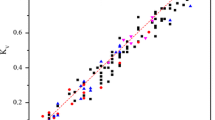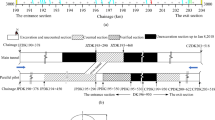Abstract
Safe construction and operation of tunnels in high seismic risk regions require special aseismic design. A possible solution to this issue is to consider the earthquake damage that a tunnel may suffer beforehand in the process of engineering rock mass classification during the geotechnical investigation phase. Then, the tunnel support system is designed with this modified classification result. To verify this hypothesis, this work investigates the Chinese engineering rock mass classification system, the basic quality (BQ) rating system, considering seismic effects. The main contribution of the current work is to quantitatively modify the rock mass intactness index Kv in the BQ system considering the potential earthquake damage under various levels of design peak ground acceleration. The procedure to obtain the rock mass basic quality index considering the design peak ground acceleration is proposed and verified with real field data from the 2008 Wenchuan earthquake. This approach is a promising enhancement of the empirical methods for considering the seismic effects for tunnels that require special design against possible earthquake impacts.









Similar content being viewed by others
Abbreviations
- BQ:
-
Basic quality index
- [BQ]:
-
Corrected basic quality
- D :
-
Span of the tunnel
- J v :
-
Volumetric joint number
- K v :
-
Intactness index of the rock mass
- PGA:
-
Peak ground acceleration
- R c :
-
Saturated intact uniaxial compressive strength
- V pm :
-
P wave velocity of the rock mass
- V pr :
-
P wave velocity of the intact rock
- η :
-
Seismic axial force multiplier of the tunnel liner
References
An B (2013) Discussion on engineering properties and of treatment measures of tunnel crossing shattered rock. Chengdu, Chengdu University of Technology (in Chinese)
Barton N (1984) Effects of rock mass deformation on tunnel performance in seismic regions. In: Proceedings of Caracas symposium on advances in tunneling technology and subsurface use 4(3): 89–99
Barton N (2002) Some new Q-value correlations to assist in site characterisation and tunnel design. Int J Rock Mech Min Sci 39(2):185–216
Barton N, Lien R, Lunde J (1974) Engineering classification of rock masses for the design of tunnel support. Rock Mech 6(4):189–236
Bieniawski ZT (1973) Engineering classifications of jointed rock masses. Trans S Afr Inst Civ Eng 15:335–344
Bieniawski ZT (1989) Engineering rock mass classifications. Wiley, New York
Glass CE (1973) Seismic consideration in siting large underground openings in rock. University of California, Berkeley
Hajiazizi M, Sadat Khatami R (2013) Seismic analysis of the rock mass classification in the Q-system. Int J Rock Mech Min Sci 62:123–130
Hashash YMA, Hook JJ, Schmidt B et al (2001) Seismic design and analysis of underground structures. Tunn Undergr Sp Technol 16:247–293
Hoek E, Brown ET (1997) Practical estimates of rock mass strength. International Journal of Rock Mechanics and Mining Sciences and Geomechanics Abstracts 34(8):1165–1186
Hoek E, Brown ET (2019) The Hoek-Brown failure criterion and GSI - 2018 edition. J Rock Mech Geotech Eng 11(3):445–463
Hoek E, Diederichs MS (2006) Empirical estimation of rock mass modulus. Int J Rock Mech Min Sci 43(2):203–215
Hoek E, Marinos P, Benissi M (1998) Applicability of the Geological Strength Index (GSI) classification for very weak and sheared rock masses. The case of the Athens schist formation. Bull Eng Geol Environ 57(2):151–160
Hoek E, Carranza-Torres C, Corkum B (2002) Hoek-Brown criterion-2002. In: Hammah R, Bawden W, Curran J, Telesnicki M (eds) Mining and tunneling innovation and opportunity, proceedings of the 5th North American rock mechanics symposium and 17th tunnelling association of Canada conference. University of Toronto, Toronto, Canada. Toronto, pp 267–273
Kayen R, Brandenberg SJ, Collins BD (2009) Geoengineering and seismological aspects of the Niigata-Ken Chuetsu-Oki earthquake of 16 July 2007. Earthquake Spectra 25(4):777–802
Liu H (2016) Research on mechanics of earthquake damage and stability of seriously damaged tunnel section in earthquake-prone area during construction period. Chengdu, Southwest Jiaotong University (in Chinese)
Meng LB, Li TB, Zeng ZF (2012) Discussion of surrounding rock classification for tunnels in shattered rock masses. Modern Tunnelling Technology 49(1):27–32 (in Chinese)
Palmström A (1995) RMi - a rock mass characterization system for rock engineering purposes. Oslo, University of Oslo
Palmström A (1996) Characterizing rock masses by the RMi for use in practical rock engineering. Part 1: the development of the rock mass index (RMi). Tunn Undergr Space Technol 11(2):175–186
Palmström A (2000) Recent developments in rock support estimates by the RMi. Journal of Rock Mechanics and Tunnelling Technology 6(1):1–19
Palmström A (2009) Technical note. Combining the RMR, Q, and RMi classification systems. Tunn Undergr Space Technol 25:491–492
Rocscience Inc (2015) RS2 - finite element analysis for excavations and slopes. www.rocscience.com, Toronto, Ontario, Canada
Stille H, Palmström A (2003) Classification as a tool in rock engineering. Tunn Undergr Space Technol 18:331–345
Terzaghi K, White T (1946) Rock defects and load on tunnel support, rock tunneling with steel supports. Commercial Shearing Co, Youngstown, OH, pp 15–99
The National Standards Compilation Group of People’s Republic of China (2014) GB/T 50218-2014 Standard for engineering classification of rock masses. China Planning Press, Beijing, pp 1–22 (in Chinese)
Wang WL, Wang TT, Su JJ et al (2001) Assessment of damage in mountain tunnels due to the Taiwan Chi-Chi Earthquake. Tunn Undergr Sp Tech 16(3):133–150
Wang ZZ, Gao B, Jiang YJ, Song Y (2009) Investigation and assessment on mountain tunnels and geotechnical damage after the Wenchuan earthquake. Sci China Ser E Technol Sci 52:546–558
Yashiro K, Kojima Y, Shimizu M (2007) Historical earthquake damage to tunnels in Japan and case studies of railway tunnels in the 2004 Niigataken-Chuetsu earthquake. Quarterly Report of Railway Technical Research Institute 48(3):136–141
Zhang ZR (2010) Study on deformation properties of fractured rock mass. Wuhan, Institute of Rock and Soil Mechanics, Chinese Academy of Sciences (in Chinese)
Funding
This work is supported by the National Key Research and Development Program of China (no.2016YFC0401803), the National Natural Science Foundation of China (no.41672319, no.51779253, and 52079133), Major project of the National Basic Research Program of China (no. 51991393), the Key Laboratory for Geo-Mechanics and Deep Underground Engineering, China University of Mining & Technology (no. SKLGDUEK1912), CRSRI Open Research Program (program SN: CKWV2019746/KY), MOE Key Lab of Disaster Forecast and Control in Engineering, Jinan University (no. 20200904002), and the Youth Innovation Promotion Association CAS.
Author information
Authors and Affiliations
Corresponding author
Rights and permissions
About this article
Cite this article
Cui, Z., Sheng, Q., Zhang, Gm. et al. A modified rock mass classification considering seismic effects in the basic quality (BQ) system. Bull Eng Geol Environ 80, 2249–2260 (2021). https://doi.org/10.1007/s10064-020-02064-7
Received:
Accepted:
Published:
Issue Date:
DOI: https://doi.org/10.1007/s10064-020-02064-7




